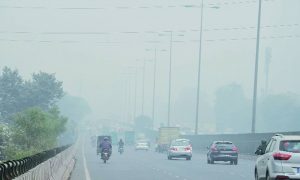Groundwater in many parts of Delhi was found to be brackish, the level of nitrates was high in Northeast Delhi, and heavy metals like uranium were found to be above permissible limits in some parts of the city, according to a report of the Central Ground Water Board (CGWB).
The Groundwater Yearbook for Delhi-2021-22, which was prepared in September last year with samples collected in May 2021, stated: “Chemical analysis of groundwater samples collected during May 2021 shows that nitrate content in groundwater is within the permissible limit of 45 mg/l in most of the state and the concentration in northeastern parts of Delhi shows higher nitrate content.”
Nitrate is a naturally occurring compound that is formed in the soil when nitrogen and oxygen combine and nitrate in groundwater generally originates from non-point sources such as leaching of chemical fertilisers and animal manure, groundwater pollution from septic and sewage discharges etc, the report explains. “Though nitrate is considered relatively non-toxic, a high nitrate concentration in drinking water is an environmental health concern arising from increased risks of methemoglobinemia, particularly to infants,” it added.
The report said groundwater is fresh at all depths around the Ridge in Central, New Delhi, South and eastern part of Southwest districts and also in the Chhatarpur basin. Areas of Tagore Garden, Nizampur, Jharoda Kalan, and some parts of Shahdara show “exceptionally high EC (electrical conductivity) values” even in shallower depth, the report showed.
Electrical conductivity is a measure of the salinity of the groundwater, calculated as microsiemens/cm (μS/cm). When the EC value is between 1500 and 15,000 μS/cm, groundwater is considered to be brackish.
The report stated: “It is observed that nearly 39.3% areas of NCT Delhi falling in North, North West, West and South West districts show EC more than 3000 µS/cm whereas the remaining 60.7 % area has EC in the range from 0 to 3000 µS/cm. Nearly 3.8% areas of North, New Delhi, South East & South districts have an EC of 0 to 750 µS/cm.”
Read More: G20: First Environment and Climate Sustainability Meeting in Bengaluru from Tomorrow
“In the ridge area, fresh water is available, since recharge is high. Water is brackish in other areas where the soil is alluvial or the aquifer is fine silt or sandy aquifer. Brackishness depends on the soil,” said an official of the CGWB state unit.
The report also said that the Aravalli ridge area is the main recharge zone for the national capital territory.
On heavy metal analysis for samples collected in May 2021, the report said: “Out of 77 locations, the highest concentration of manganese i.e. 2.293 mg/l was recorded at Jagatpur.”
High iron concentrations of more than 1 mg/litre were recorded at four locations – Rohini Sector-11, Nangli Rajapura, Bhalswa Lake and Burari.
Uranium concentrations were found to be beyond permissible limits in Kanjhawala, Jaunti, and Nizampur. A CGWB report from 2020 on uranium in groundwater said, “Uranium is a naturally occurring radioactive chemical element that occurs in low concentrations in nature. It is present in certain types of soils and rocks, especially granites. Studies have revealed that the presence of uranium in drinking water causes nephritis (kidney damage).”





































